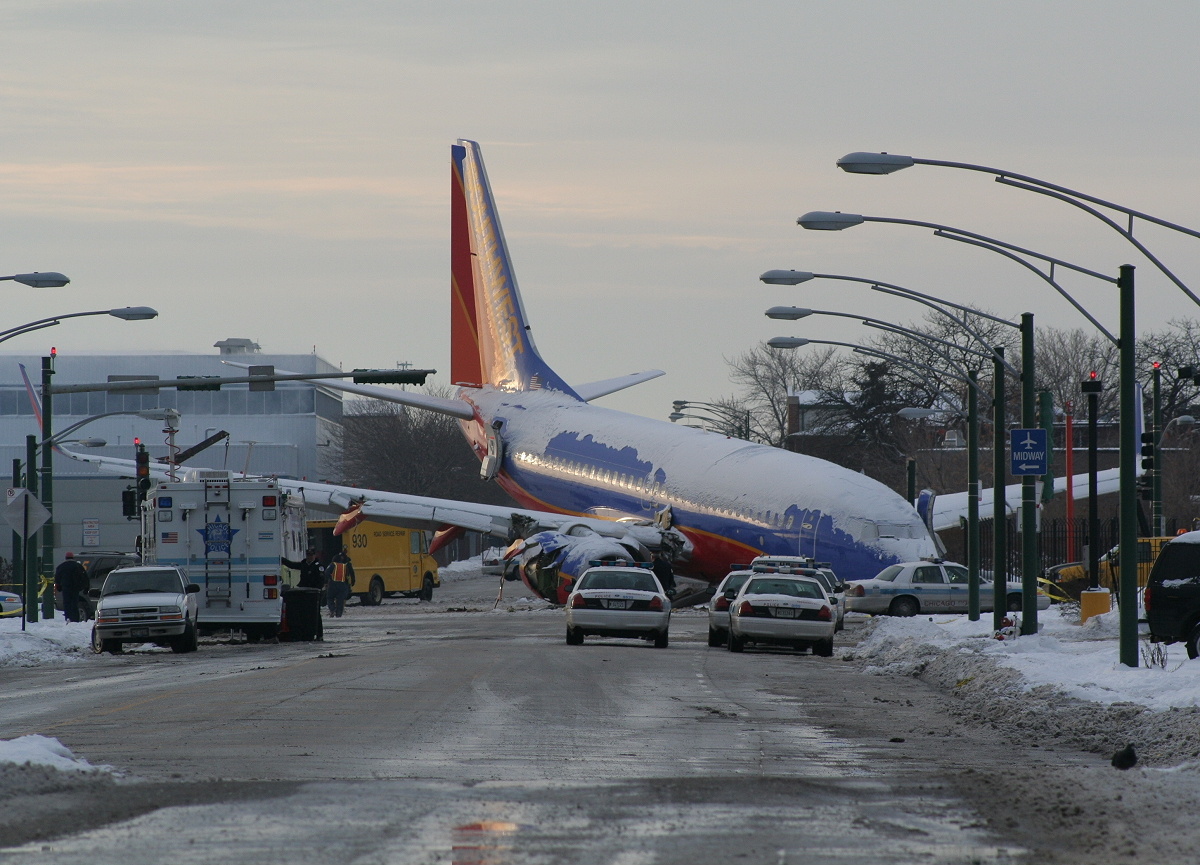Southwest Airlines Flight with over 187 passenger Skidded off runway
Southwest Airlines Flight 1248, a Boeing 737-7H4, encountered a runway overrun incident at Chicago Midway International Airport. The aircraft, attempting to land during a snowstorm, skidded off the runway and onto a nearby road, resulting in the tragic death of a six-year-old boy and injuries to several others.
Flight Details and Crew Information
Flight 1248 originated from Baltimore-Washington International Thurgood Marshall Airport, with scheduled stops at Chicago Midway International Airport, Salt Lake City International Airport, and a final destination of Las Vegas McCarran International Airport. The aircraft involved was a Boeing 737-7H4, tail number N471WN, which had been in service for approximately one year at the time of the incident.
The flight crew consisted of Captain Bruce Sutherland, 59, and First Officer Steven Oliver, 34. Captain Sutherland had an extensive aviation background, including service as a U.S. Air Force pilot from 1969 to 1995, and had accumulated 15,000 flight hours, with 4,500 hours on the Boeing 737. First Officer Oliver had logged 8,500 flight hours, 2,000 of which were on the Boeing 737. Both pilots had clean safety records prior to this incident.
Weather Conditions and Landing Attempt
On the evening of December 8, 2005, Chicago was experiencing a significant snowstorm, with nearly eight inches of snow on the ground and visibility reduced to less than one mile. Despite these challenging conditions, airport officials reported that the runway had been cleared of snow before Flight 1248’s landing attempt. The wind was reported from the east-southeast at 11 knots.
The crew chose to land on Runway 31C, which resulted in a tailwind during landing—a factor that can increase landing distance. The aircraft touched down approximately 2,000 feet beyond the runway threshold, leaving about 4,500 feet of usable runway remaining. Despite deploying thrust reversers and brakes, the aircraft was unable to stop before the runway’s end.
Runway Overrun and Collision
The aircraft skidded off the end of the runway, broke through the airport’s perimeter fence, and entered the intersection of West 55th Street and South Central Avenue. In the process, it collided with several vehicles. Tragically, six-year-old Joshua Woods, a passenger in one of the vehicles, was killed. Five occupants of another vehicle, including two adults and three children, sustained critical injuries. Additionally, four occupants of a second car were seriously injured. Three passengers from the aircraft were taken to hospitals with minor injuries. In total, 12 people were hospitalized following the accident.
Investigation Findings
The National Transportation Safety Board (NTSB) conducted a thorough investigation into the incident. The findings highlighted several critical factors:
Pilot Decision-Making: The decision to land on a runway with a tailwind in adverse weather conditions was a significant factor. Landing with a tailwind can substantially increase the required stopping distance.
Runway Conditions: Although the runway was reported clear, the snowstorm and reduced visibility contributed to challenging landing conditions.
Aircraft Performance Calculations: The investigation revealed that the pilots relied on landing distance calculations that did not adequately account for the prevailing conditions, leading to an underestimation of the required stopping distance.
Safety Recommendations and Changes
In the aftermath of the incident, several safety recommendations and changes were implemented:
Runway Safety Areas: The incident underscored the importance of adequate runway safety areas (RSAs). Midway Airport, like many older airports, had limited space for RSAs. Following the incident, there was a push to install Engineered Materials Arrestor Systems (EMAS) at airports where standard RSAs are not feasible. EMAS can safely decelerate an overrunning aircraft, reducing the risk of accidents.
Pilot Training and Procedures: Southwest Airlines reviewed and updated its pilot training programs to emphasize the risks associated with landing in adverse conditions, particularly with tailwinds. Procedures for calculating landing distances were also revised to ensure more accurate assessments under varying conditions.
Weather Reporting and Communication: Enhancements were made in how weather information is communicated to flight crews, ensuring that pilots have the most accurate and up-to-date information when making landing decisions.
Impact on Aviation Safety
The Flight 1248 incident served as a catalyst for broader changes in aviation safety:
Industry-Wide Awareness: The incident raised awareness about the dangers of runway overruns, leading to industry-wide discussions and initiatives to mitigate such risks.
Regulatory Changes: Aviation authorities revisited regulations and guidelines concerning landing procedures in adverse conditions, emphasizing the need for conservative decision-making and the importance of adequate runway safety measures.
Technological Advancements: The incident highlighted the potential benefits of technologies like EMAS, leading to increased adoption at airports worldwide.






